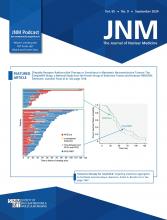REPLY: We are grateful for the interest in our article and the insightful comments received. We recognize the complexity of imaging in primary aldosteronism and acknowledge the continuous advancements in this field.
In agreement with the authors of the letter to the editor regarding our article, “Clinical Value of 68Ga-Pentixafor PET/CT in Subtype Diagnosis of Primary Aldosteronism Patients with Adrenal Micronodules,” we highlighted that existing methods such as 131I-NP-59 and 11C-metomidate have notable limitations (1). The utility of 11C-metomidate is constrained by the short half-life of 11C, making it less practical for routine clinical use. Similarly, 131I-NP-59, despite being a functional imaging agent based on steroid production, has unfavorable imaging characteristics and requires dexamethasone suppression, making it cumbersome for routine screening.
As mentioned in the letter to the editor, recent developments in NP-59 imaging, particularly the improved 18F-labeled version (FNP-59), are noteworthy. Brooks et al. demonstrated that FNP-59 can serve as a true functional imaging agent, reflecting hormone synthesis within the adrenal gland (2). This advancement addresses some of the limitations of 131I-NP-59, particularly its imaging characteristics and dosimetry. The ester version of FNP-59, which shows significantly improved uptake in the adrenal gland, represents a promising improvement. We acknowledge the value of such functional imaging agents in providing crucial insights into hormone synthesis and adrenal gland function. However, our study focused on the utility of 68Ga-pentixafor PET/CT as a nonfunctional imaging agent for identifying adrenal microadenomas and differentiating unilateral from bilateral adrenal disease. Despite being a nonfunctional agent, pentixafor targets the C-X-C motif chemokine receptor 4, which is overexpressed in various adrenal pathologies, thereby offering valuable diagnostic information.
Our findings demonstrated that 68Ga-pentixafor PET/CT has higher diagnostic accuracy than adrenal CT and shows better concordance with surgical outcomes than does adrenal venous sampling. 68Ga-pentixafor PET/CT offers a practical, noninvasive alternative for initial diagnostic work-up, particularly in patients for whom adrenal venous sampling is not feasible or fails.
We acknowledge that pentixafor has limitations as a nonfunctional agent, especially in quantifying hormone dysfunction or autonomy within the adrenal gland. However, its role in evaluating adrenal lesions, such as nodules or adrenocortical carcinoma, remains significant. The ability to identify C-X-C motif chemokine receptor 4 expression provides valuable diagnostic and potentially prognostic information, contributing to personalized patient management.
We agree that advancements in functional imaging agents such as FNP-59 hold potential for the future of adrenal imaging. However, 68Ga-pentixafor has evidentially provided a practical, noninvasive alternative for initial diagnostic work-up for primary aldosteronism, particularly for differentiating subtypes in patients with adrenal micronodules. Further research and technologic advancements will continue to refine and enhance the imaging techniques, ultimately improving patient outcomes.
DISCLOSURE
No potential conflict of interest relevant to this article was reported.
Xiang Li, Li Huo*
Peking Union Medical College Hospital Beijing, China
*E-mail: huoli{at}pumch.cn
Footnotes
Published online Jul. 25, 2024.
- © 2024 by the Society of Nuclear Medicine and Molecular Imaging.
- Received for publication July 4, 2024.
- Accepted for publication July 10, 2024.







